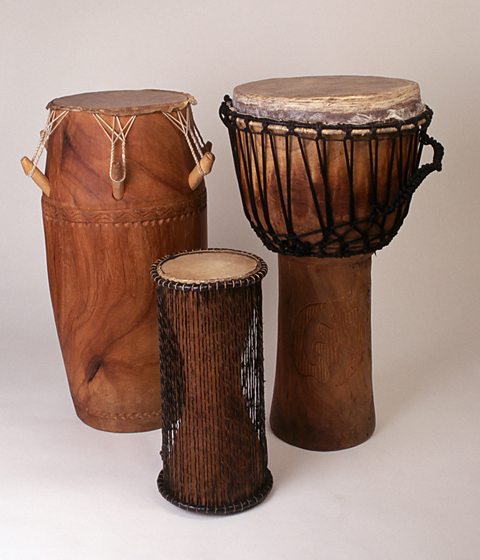Sonority - percussion
In the Baroque and Classical periods the percussion section of the orchestra was limited to the timpani. During the Romantic period the percussion section grew. Cymbals, triangles and bass drums became important parts of the untuned percussion section. The xylophone, glockenspiel and related instruments formed the tuned percussion section. In the Romantic period and beyond, the percussion became a much larger part of orchestral music.
World music

Musical styles from around the world feature percussion instruments.
African drumming
African instruments т hand drum, don-don and djembe
- They are usually made from wood, metal, earthenware, or large gourds - fruit with a hard rind.
- African drums have different shapes - tubular, bowl-shaped and friction drums. Some have one head, others have two.
- They come in different sizes. The bigger the drum - the lower the note. The more tension in the drum head - the higher the note produced.
- They sometimes have rattling metal and jingles attached to the outside, or seeds and beads placed inside the drum.
- They are sometimes held under the armpit or with a sling.
One of the best-known African drums is the West African djembe (pronounced zhem-bay). It is shaped like a large goblet and played with bare hands. The body of the djembe is carved from a hollowed trunk and is covered in goatskin.
Talking drums imitate the rhythms and intonations of speech.
They are double-headed and belong to the family of hourglass-shaped pressure drums. They are played with a beater. The drums can be used to imitate speech patterns or as signals to make announcements or warnings. The pitch of the note is changed by squeezing or releasing the drum's strings with the arm.
Samba drumming
Samba drumming involves percussion instruments such as the surdo, tamborim, agogo bells and ganza.
Indian classical music
Tabla are important in Indian classical music. Tabla are a pair of small drums placed side by side on the floor in front of the player. They are used mainly to keep the time, but tabla players sometimes interact with the soloist and may have short solos themselves. The tabla heads are made out of goatskin with a central area which has a coating made from iron filings and rice flour.
The smaller drum is known as the dayan , or тrightт. It is:
- tuned to Sa
- played with the fingertips of the right hand
- quite high in pitch
The larger drum is known as the bayan, or 'left'. It is:
- played with the left hand
- played with the heel of the hand, which is pressed into the drum to change the pitch, providing a distinctive sound
- deeper in pitch, providing a bass sound
Tabla playing is very difficult and it can take years to master the different strokes, or bols. Some strokes are open (allowed to ring) and others are closed (dampened).
| 1 | 2 | 3 | 4 | 5 | 6 | 7 | 8 | 9 | 10 | 11 | 12 |
| clap | clap | wave | clap | wave | clap |
| 1 | clap |
|---|---|
| 2 | |
| 3 | clap |
| 4 | |
| 5 | wave |
| 6 | |
| 7 | clap |
| 8 | |
| 9 | wave |
| 10 | |
| 11 | clap |
| 12 |
Bhangra
Bhangra originated in the Punjab region of India. Traditionally, a good harvest was celebrated by dancing and singing songs to the sound of the dhol drum.
In Bhangra music the dhol provides a bass part. Tabla or dholak add a decorative part above the bass.
The dhol is a large traditional North Indian drum played with cane sticks. The tension of the dhol is adjusted to produce a bass and treble sound. It is extremely loud.
The dholak is a double-headed hand-drum often slung from the shoulder.
Bhangra is now used to describe a high-energy style of dance music developed by young Asians and performed at weddings, parties and clubs.
Popular music
The percussion in popular music is mostly provided by the drum kit. The main roles of the drum players are to maintain a steady beat and to add rhythmic interest to pop song.
Here is a labelled drum kit:
Drum terms and techniques
Four-to-the-floor
This term refers to the four crotchets in 4/4 time played on the bass drum. Four-to-the-floor is often used in disco music and electronic dance music.
Back beat
Back beat is when the snare drum plays on beats 2 and 4 of 4/4 time. This is often found in pop ballads.
Drum roll
A drum roll is a rapid succession of beats sounded on a drum. It is often used to introduce an announcement or event.
Rim shot
A rim shot is a drum stroke in which the stick strikes the rim and the head of the drum at the same time.